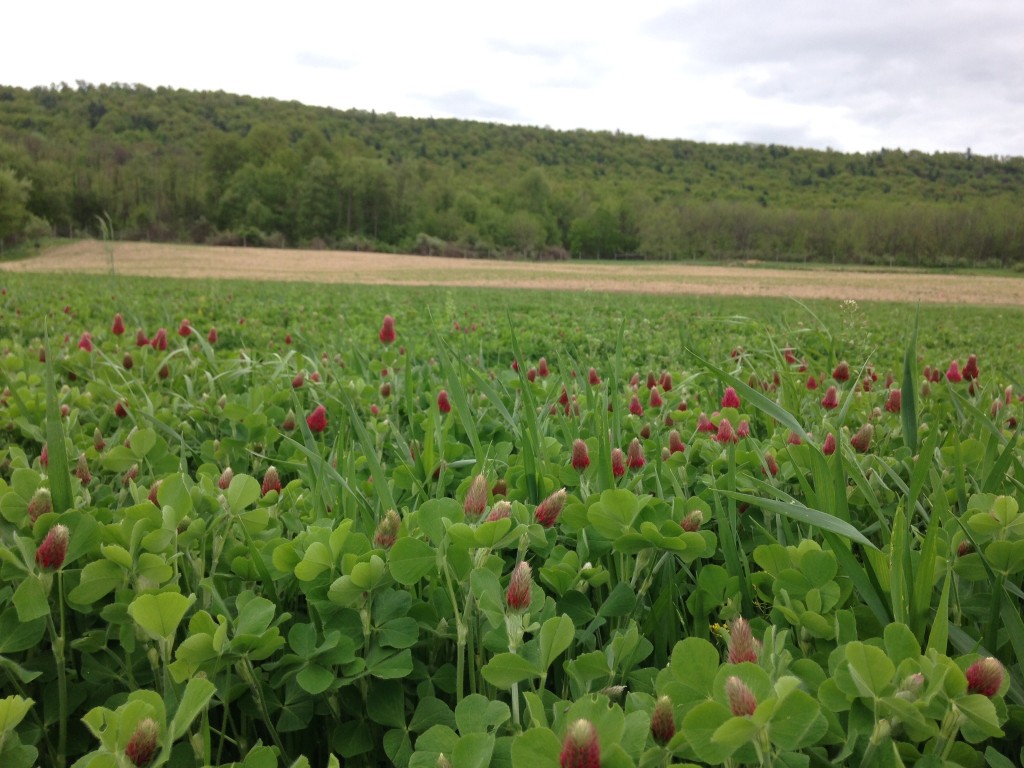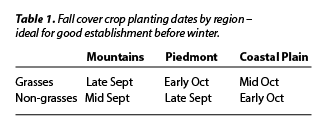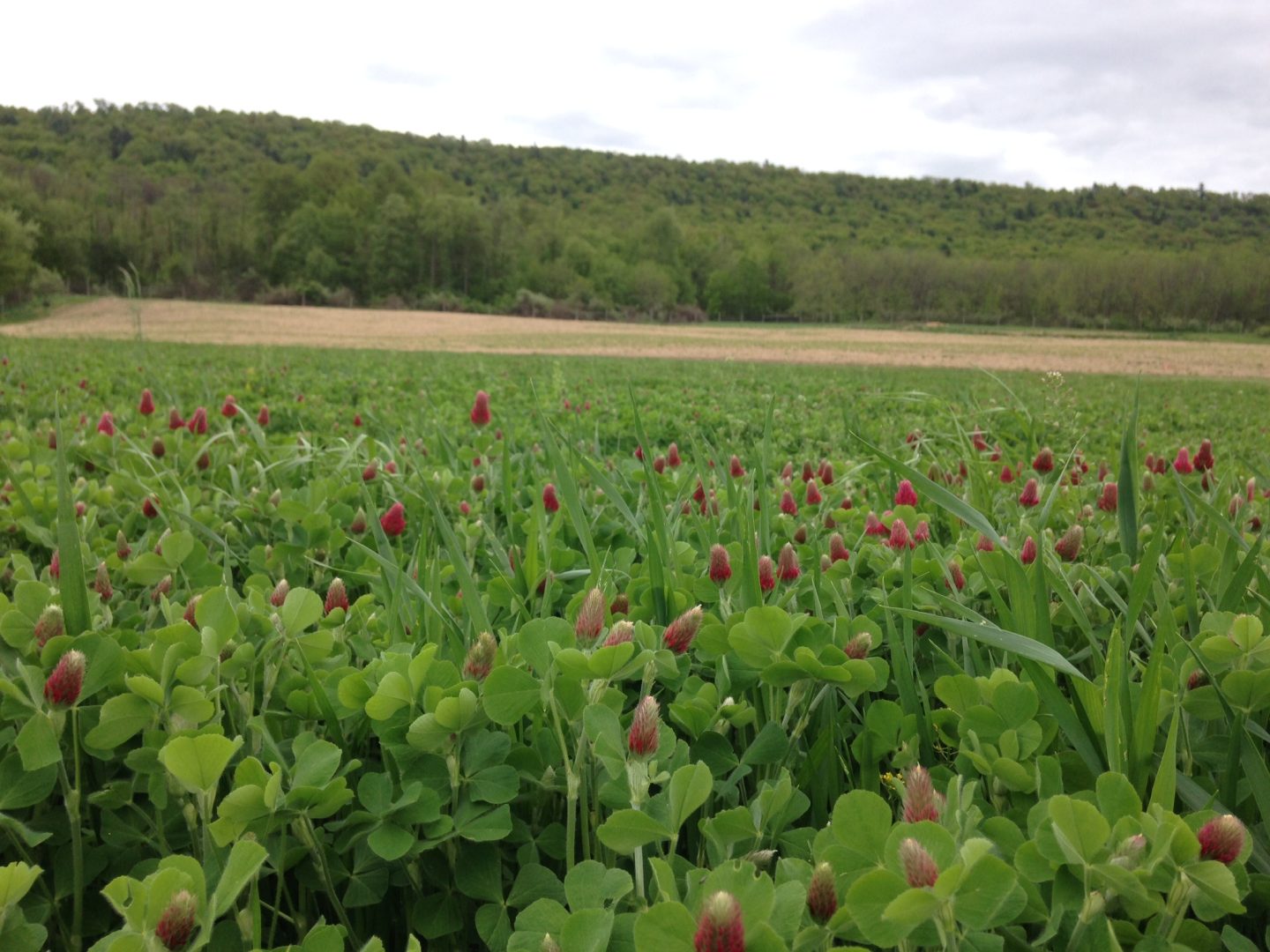by Mark Dempsey, CFSA Farm Services Coordinator

It’s mid-season in the Carolinas, and for growers this typically means spring crops are finished, summer crops are keeping you busy, and you’re starting fall crops. This is a good time to consider whether to plant cover crops in some fields this fall instead of all cash crops.
Most growers in the Carolinas take full advantage of our climate by growing three seasons out of the year, sometimes with a short-season winter cover crop sown in the late fall. While maximizing the time cash crops are in the ground is a common sense approach to maximize revenue for your farm, it minimizes the benefits from cover crops, which don’t always come with a return in dollars – at least not immediately. So, when should you swap a fall cash crop for a fall-planted winter cover crop?
The answer to this question is never simple and depends on a constellation of factors such as crop price point, input costs, tillage practices, pest pressure, and more. While you can be pretty certain that not growing a fall crop will reduce revenue in any given year, when you substitute a cover crop there’s potential to earn some of that “lost” revenue back, and earn much more in other benefits that aren’t easily converted to dollars. Perhaps the best way to answer the question of whether to swap a cash crop for winter cover crop is to answer a few other questions:
Have you seen signs of soil erosion this year or last year?
Soil erosion rates often exceed rates of soil building, potentially making erosion a big problem. A well-established winter cover crop can reduce erosion by covering soil, and more importantly by holding onto it with roots. Winter cover crops play a particularly important role in the fall when rainfall outpaces evapotranspiration, quickly leading to saturated soils and a good chance for erosion.
Have you been tilling intensively, or are you growing in a low-organic matter soil?
Intensive tillage, such as roto-tilling or multiple passes with a plow and disk, can decrease soil organic matter by stimulating its decomposition by microorganisms. The loss of this organic matter is concerning because, in its many forms, soil organic matter is critical in maintaining soil health. Replacing the organic matter that’s decomposed or building organic matter in a low-organic matter soil is important for maintaining crop productivity. Cover cropping can help increase organic matter because cold-hardy cover crops take advantage of the few months of the year when cash crops aren’t in the ground, allowing for plant biomass (i.e. organic matter) to be produced when it wouldn’t otherwise have been, and all that biomass is inevitably returned to the soil.
Do you grow crops with a high nitrogen (N) demand and invest substantially in fertilizer?
Organic fertilizers, in the form of manure, mined minerals, or plant/animal by-products, are often the most expensive input – apart from labor – when growing crops that have a high N demand. Growing a winter legume cover crop such as hairy vetch or crimson clover can add 50-100 lbs N/acre, depending on time allowed to grow. Most of that N is available to the subsequent crop. On the flip side of this, if you suspect that you lose a lot of N to leaching (where water-soluble N is washed below the root zone of your cash crop) then an N-scavenging winter cover crop such as a grass or radish can help recover some of that N.
Is weed pressure high or getting worse?
Winter annual weeds can be a problem in spring crops, and many of them germinate in the fall. Establishing a cover crop in the fall can prevent weed seed germination and more importantly can suppress weed growth in the spring.
If you answered “yes” to any of these questions you should consider ways to incorporate cover cropping into your operation.
Cover Crop Considerations
The type of cover crop you choose to grow, and how you manage it, is largely determined by your goals, but your priority for a good winter cover crop should always be to get it established early and to let it grow into the spring as long as possible.

Grasses can be planted later (about 2 weeks) than non-grasses such as legumes and brassicas because grasses are quicker to establish (Table 1).
Early establishment means good cover and root development before winter, reducing soil erosion. Further, because it’s better developed when spring arrives, an early-planted cover crop puts on more biomass, contributes more fixed N (if a legume), scavenges more soil N (if a non-legume), and better suppresses weeds in the spring compared to a late-planted cover crop.
This is precisely why a fall cash crop may have to be sacrificed to achieve early cover crop establishment. There may be opportunity to inter-seed a cover crop into a fall crop, provided that the cover crop spans row-to-row and can survive the maintenance and harvest of the fall crop. After winter, the longer that cover crop termination is delayed in the spring (up to flowering) you should expect greater benefits from your cover crop.
Selection of the cover crop is dependent on your individual goals. Consider whether you want to fix N vs scavenge N and other nutrients. Legumes will do a good job of fixing N, but not necessarily scavenging nutrients, while non-legumes are great nutrient scavengers, but do not fix N.
An additional consideration is how quickly a cover crop forms a canopy, for soil coverage or weed suppression. Fast-growing cover crops such as oats, rye, and radish, will cover the soil quicker than other cover crops.
A final consideration is winter-hardiness: rye, barley, hairy vetch and many clovers are considered winter-hardy in the Carolinas, whereas oats, peas and radish will winter-kill during prolonged freezes. Winter-killed cover crops are useful if you’d like to no-till plant a spring crop; otherwise winter-hardy ones provide greater benefit.
There are many trade-offs inherent in planting a fall cash crop versus a cover crop. The major drawback to swapping a cash crop for a cover crop is the lack of revenue from the cash crop, however some of that lost revenue can be recouped the next season by reducing fertilizer use and time spent weeding.
The many other benefits of using a cover crop are hard to quantify in dollars and it’s possible that rebuilding lost or degraded soil is an investment that will payoff only after many years of practice.
Ultimately, the choice is up to you, and depends on how much you can afford to lose (revenue or soil), how bad your weed pressure and nutrient problems are, and how well you can incorporate winter cover crops into your rotation.
Additional resources for growers can be found at /forgrowers/ and by subscribing to our monthly e-newsletter for sustainable and organic farmers, The Grower’s Toolbox.


